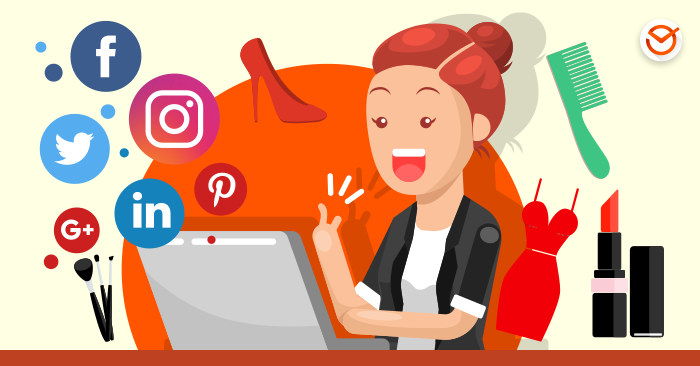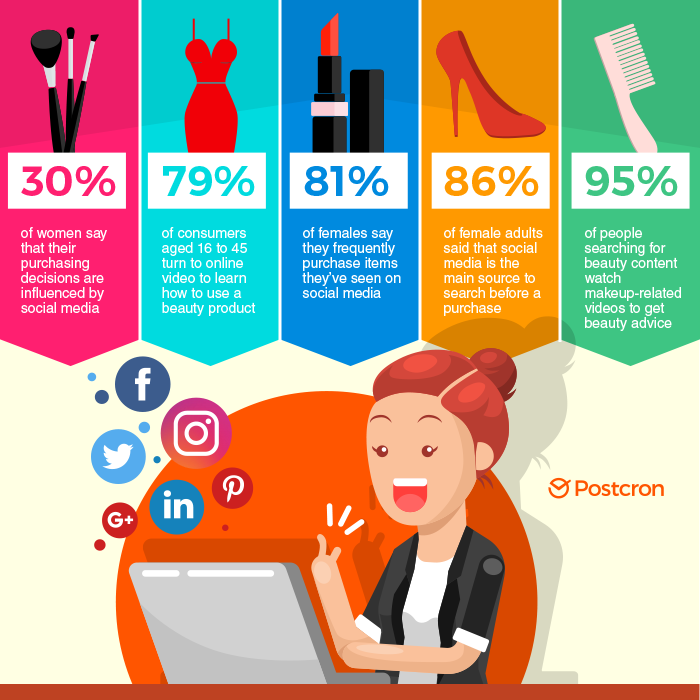Without question, the face of the health and beauty industry has changed. Gone are the days when individuals would flock to department store counters to catch a whiff of the hottest fragrance or try out the latest cosmetics products.
Today’s consumers turn to their social networks for everything from beauty tips and product recommendations to makeup tutorials and online purchases. When it comes to choosing which products to buy, flashy ads and swatches no longer hold the influence they once did.
Don’t believe us? Just consider the following stats:
- 30% of women say that their purchasing decisions are influenced by social media
- 79% of consumers aged 16 to 45 turn to online video to learn how to use a beauty product
- 81% of females say they frequently purchase items they’ve seen on social media
- 86% of female adults say social media content has become a chief source of online research when they’re thinking about making a purchase
- 95% of people searching for beauty content watch makeup-related videos to get beauty advice
At Postcron, we’re continuously testing and constantly measuring. The data we’ve gathered from businesses currently using our social scheduling tool has revealed results that are right in line with these numbers.
So, why is social media such a powerful influencer? Well, for one, its size is astronomical.
In fact, across all social networks, one out of every three people on Earth is using social media in some capacity. Add to this the fact that the average person spends about two hours a day engaging in social networking and it’s easy to understand why these online communities have such an impact on our daily decisions.
The Changing Face of Social Selling
Another way that social has changed the health and beauty industry is in the way it has changed the relationship between brands and consumers.
For instance, the nature of social networks has facilitated a marked increase in the number of freelance entrepreneurs and direct sale distributors finding success on sites like Facebook and Instagram.
One need only looks to their own social connections to see an upswing of representatives hosting pop-up parties for companies like Jamberry, Younique, and Lularoe (just to name a few).
Now, thanks to social media, people can market, sell, buy and distribute everything from cosmetics and weight loss products to boutique clothing and essential oils – all from the comfort of their own homes.
At Postcron, we’ve seen quantifiable evidence of the power of social media in this sector, with health and beauty businesses making up the second largest segment of clients who use our social scheduling tool (a number that’s steadily on the rise). Of that group, a significant portion is made up of direct sales companies, further driving home the value of social media marketing for this demographic.
The health and beauty businesses are one of the most important and challenging segments for us in Postcron, and as we can see in our database, it includes:
- Hospitals, clinics, and care centers
- Beauty treatments
- beauty salon
- Diets and supplements
- Sports and Martial Arts
- Perfumes and cosmetics
What this means for today’s consultants, direct sellers, distributors, and business owners is that social media is the place to be to reach more prospects, engage with existing clientele and achieve the growth and success they’re striving for.
Best Practices for Health/Beauty Social Selling
Of course, simply pointing out the fact that social networking is a powerful tool for marketing health and beauty products isn’t going to do much in terms of achieving actual results.
There’s still a certain degree of strategy that must be applied, particularly given the amount of competition in each sector. In order to be the most successful Avon representative in your area, for instance, you’ve got to find a way to stand out as better than the dozens of others also marketing their product lines on social media.
That being said, here are a few expert pointers for leveraging the power of social to gain more traction for your health and beauty business.
Live Stream
One of the biggest keys to success when it comes to social selling is finding a way to make real, authentic and meaningful connections with your audience. This can be challenging given the lack of face-to-face interactions.
Live streaming can effectively break down those barriers and provide a way to personally connect and engage with your prospects and customers. Facebook Live, for instance, drives comments at a rate of over ten times that of non-live videos.
A great use case example of this from a health and beauty perspective is Mary Kay, which regularly live streams events, attracting hundreds of thousands of views and strengthening the connection between viewers and the people behind the company.
Host Facebook Parties
With 1.23 billion daily active users and each of those users averaging about 338 friends, it’s no wonder Facebook has become such a powerhouse for driving direct sales efforts.
Furthermore, studies indicate that social networks influence 74 percent of consumer buying decisions, which means that hosting a virtual party to market your health and beauty products can be highly effective in generating both word of mouth referrals as well as more sales. (Here are a few helpful tips for running a successful Facebook party.)
Publish Tutorials
As mentioned earlier, 79% of consumers say they use online video to learn how to use a beauty product. By leveraging this statistic in your favor, not only will you effectively connect with more of your target audience, but you’ll also be fulfilling a specific need that they have.
And since social video generates 1200% more shares than texts and images combined, your chances of going viral are increased exponentially. To take advantage of this, publish videos that demonstrate how to use the product you’re trying to sell.
Share Strategic Content
The goal of marketing your health and beauty products on social media should involve more than just making the sale. It should also be about developing and nurturing a loyal following who will serve as both your customers as well as your evangelists. The best way to accomplish this is by committing to providing consistent, quality content.
For best results, follow the 80/20 rule, where only 20% of your posts are sales-related and the rest contain highly engaging and valuable content your audience.
Also, consider the fact that Tweets with images receive 150% more retweets than plain text and Facebook posts with visual content receive 2.3X the amount of engagement as those without images. So, be sure to use eye-catching imagery in as many of your social updates as possible.
Use the Tools Available to You
Finally, leverage the power of technology to your advantage. If you’re like most social sellers, you’re ridiculously busy.
By using tools like Postcron, you can automatically schedule updates on Facebook Pages, Facebook Groups, Facebook Events, Twitter, Linkedin, Google+, Pinterest and Instagram all from one place. When you allow technology to do the heavy lifting, you’ll be freed up to focus on what’s most important: managing and growing your successful business.
Ready to get started? Start scheduling your social media posts today by clicking here!

